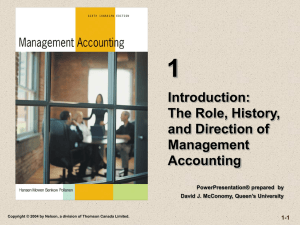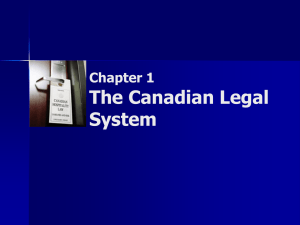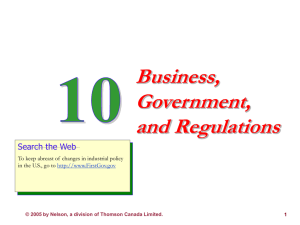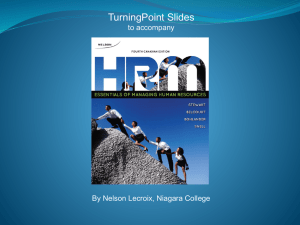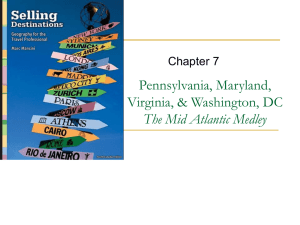Human Resource Management 1CE
advertisement
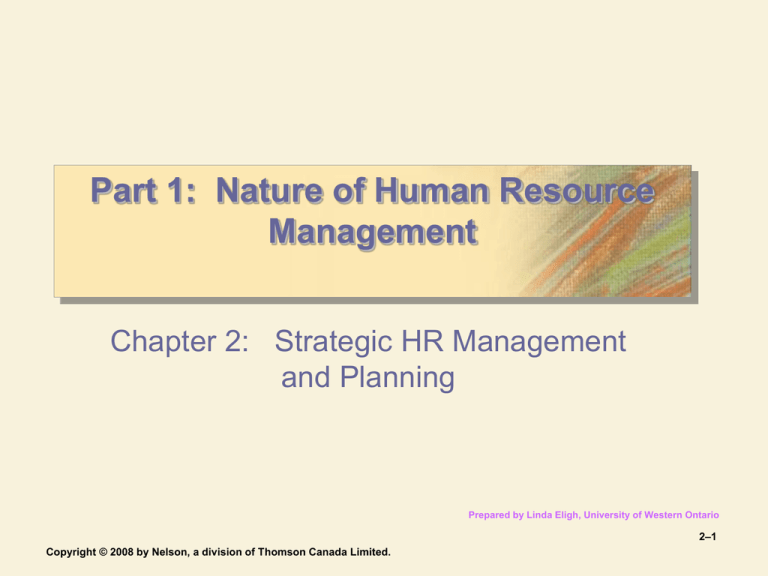
Part 1: Nature of Human Resource Management Chapter 2: Strategic HR Management and Planning Prepared by Linda Eligh, University of Western Ontario 2–1 Copyright © 2008 by Nelson, a division of Thomson Canada Limited. Learning Objectives After you have read this chapter, you should be able to: 1. Explain strategic HR management and how it is linked to organizational strategies. 2. Define HR planning and outline the HR planning process. 3. Describe the process for forecasting HR supply and demand including forecasting methods. 4. Discuss the importance surrounding the retention of employees. 5. Describe the process of developing and using a strategic HR plan including the action to be taken when there is a surplus of employees or a shortage. 6. Identify why HR metrics must consider both strategic and operational HR measures. 2–2 Copyright © 2008 by Nelson, a division of Thomson Canada Limited. Nature of Strategic Human Resources Management • Strategic Human Resources Management The process of linking the HR function with the strategic objectives of the organization in order to improve performance. • Organizational Strategy The pattern of decisions in a company that determines and reveals its objectives, purposes or goals, and produces the principle policies and plans for achieving those goals. 2–3 Copyright © 2008 by Nelson, a division of Thomson Canada Limited. Strategic HR Management Process Fig. 2-1 2–4 Copyright © 2008 by Nelson, a division of Thomson Canada Limited. Linkage of Organizational and HR Strategies Porter’s Competitive Strategies Cost Leadership Competition on the basis of low price and high quality of product or service. Relies on “building” employees to fit specialized needs and requires a longer HR planning horizon approach 2–5 Copyright © 2008 by Nelson, a division of Thomson Canada Limited. Linkage of Organizational and HR Strategies Porter’s Competitive Strategies (cont.) Differentiation Competition through offering distinctively different products or services or establishing an exclusive image for quality products and services. Relies on hiring needed skills. Needs a shorter planning time frame in order to be responsive to dynamic environments. 2–6 Copyright © 2008 by Nelson, a division of Thomson Canada Limited. Linkage of Organizational and HR Strategies Porter’s Competitive Strategies (cont.) Focused Strategy Occurs when a firm concentrates effort on serving a distinctively defined market that may include some combination of a portion of a product line, customer segment, geographic area or distribution channel. 2–7 Copyright © 2008 by Nelson, a division of Thomson Canada Limited. Linkage of Organizational and HR Strategies Miles and Snow’s Strategy Typology View of the organization as a complete and integrative system, in dynamic interaction with its environment. Competing firms within a single industry can be categorized into four basic types: Defenders Prospectors Analyzers Reactors 2–8 Copyright © 2008 by Nelson, a division of Thomson Canada Limited. Human Resource Planning • Human Resource (HR) Planning The process of analyzing and identifying the need for and availability of human resources so that the organization can meet its objectives. • HR Planning Responsibilities Top HR executive and subordinates gather information from other managers to use in the development of HR projections for top management to use in strategic planning and setting organizational goals 2–9 Copyright © 2008 by Nelson, a division of Thomson Canada Limited. Purpose of Strategic HR Planning Fig. 2-2 2–10 Copyright © 2008 by Nelson, a division of Thomson Canada Limited. Typical Division of HR Responsibilities: HR Planning Fig. 2-3 2–11 Copyright © 2008 by Nelson, a division of Thomson Canada Limited. Human Resource Planning • Small Business and HR Planning Issues Attracting and retaining qualified outsiders Management succession between generations of owners Evolution of HR activities as business grows Family relationships and HR policies 2–12 Copyright © 2008 by Nelson, a division of Thomson Canada Limited. HR Planning Process Fig. 2-4 2–13 Copyright © 2008 by Nelson, a division of Thomson Canada Limited. HR Planning Process • HR Strategies The means used to anticipate and manage the supply of and demand for human resources. Provide overall direction for the way in which HR activities will be developed and managed. Overall Strategic Plan Human Resources Strategic Plan HR Activities 2–14 Copyright © 2008 by Nelson, a division of Thomson Canada Limited. Scanning the External Environment • Environmental Scanning The process of studying the environment of the organization to pinpoint opportunities and threats. • Environmental Changes Impacting HR Governmental Influences Economic conditions Geographic and competitive concerns Workforce composition 2–15 Copyright © 2008 by Nelson, a division of Thomson Canada Limited. Assessing the Internal Workforce • Jobs and Skills Audit What jobs exist now? How many individuals are performing each job? What are the reporting relationships of jobs? How essential is each job? What jobs will be needed to implement future organizational strategies? What are the characteristics of anticipated jobs? 2–16 Copyright © 2008 by Nelson, a division of Thomson Canada Limited. Assessing the Internal Workforce • Organizational Capabilities Inventory HRIS databases—sources of information about employees’ knowledge, skills, and abilities (KSAs) Components of an organizational capabilities inventory Individual employee demographics Individual employee career progression Individual job performance data 2–17 Copyright © 2008 by Nelson, a division of Thomson Canada Limited. Forecasting HR Supply and Demand • Forecasting The use of information from the past and present to identify expected future conditions. • Forecasting Periods Short-term—less than one year Intermediate—up to five years Long-range—more than five years 2–18 Copyright © 2008 by Nelson, a division of Thomson Canada Limited. HR Forecasting Fig. 2-5 2–19 Copyright © 2008 by Nelson, a division of Thomson Canada Limited. Forecasting HR Supply and Demand • Forecasting the Demand for Human Resources Organization-wide estimate for total demand Unit breakdown for specific skill needs by number and type of employee Develop decision rules (“fill rates”) for positions to be filled internally and externally. Develop additional decision rules for positions impacted by the chain effects of internal promotions and transfers. 2–20 Copyright © 2008 by Nelson, a division of Thomson Canada Limited. Forecasting HR Supply and Demand Methods for Forecasting Demand Quantitative (Mathematical) Qualitative (Judgmental) Trend analysis Management forecasts Ratio analysis Delphi technique Scatter plot Regression analysis Nominal group technique Simulation models 2–21 Copyright © 2008 by Nelson, a division of Thomson Canada Limited. Forecasting HR Supply • Forecasting External HR Supply Factors affecting external supply Net migration for an area Individuals entering and leaving the workforce Individuals graduating from schools and colleges Changing workforce composition and patterns Economic forecasts Technological Actions of competing employers Government Other developments and shifts regulations and pressures circumstances affecting the workforce 2–22 Copyright © 2008 by Nelson, a division of Thomson Canada Limited. Forecasting HR Supply • Forecasting Internal HR Supply Review skills inventories Examine organizational charts or staffing tables Utilize a Markov analysis Replacement charts Implement succession planning The process of identifying longer-term plan for the orderly replacement of key employees. 2–23 Copyright © 2008 by Nelson, a division of Thomson Canada Limited. Markov Analysis for a Hypothetical Sales Office Fig. 2-6 2–24 Copyright © 2008 by Nelson, a division of Thomson Canada Limited. Executive Replacement Chart for Hypothetical Company Fig. 2-7 2–25 Copyright © 2008 by Nelson, a division of Thomson Canada Limited. Estimating Internal Labour Supply for a Given Unit Fig. 2-8 2–26 Copyright © 2008 by Nelson, a division of Thomson Canada Limited. Retention of Human Resources • Why People Stay or Leave—Links, Fit, and Sacrifice Culture and Values A positive, distinctive company culture aids retention by creating a “great work environment” Management and Retention If a firm is not effectively managed, employees may be “turned off” by ineffective responses and inefficiencies they deal with in their jobs. Visionary leadership is important. Job Security The extent to which high-caliber top performers are retained by the company is a key issue with other employees who view high turnover in this group as a negative. 2–27 Copyright © 2008 by Nelson, a division of Thomson Canada Limited. Drivers of Retention Fig. 2-9 2–28 Copyright © 2008 by Nelson, a division of Thomson Canada Limited. Keys to Managing Retention Fig. 2-10 2–29 Copyright © 2008 by Nelson, a division of Thomson Canada Limited. Managing Retention • Retention Measurement and Assessment Employee Surveys Exit Interviews • Determining Retention Management Actions Retention Evaluation and Followup Regular review of turnover data Tracking of intervention results and adjustment of intervention efforts 2–30 Copyright © 2008 by Nelson, a division of Thomson Canada Limited. Developing and Using a Strategic HR Plan • The ultimate purpose of the plan is to enable managers to match the supply of labour with the demand expected, given the strategies of the organization. Managing a Human Resources Surplus Outplacement Services HR Planning in Mergers and Acquisitions Managing Shortages of Labour 2–31 Copyright © 2008 by Nelson, a division of Thomson Canada Limited. Managing a Human Resources Surplus • Workforce Reductions and Legislation Employment Standards Acts and Canada Labour Code sets out employer requirements for advance notice of a layoff or facility closing. Sufficient notice to employees and the local community before a layoff or facility closing involving more than 50 people. Also covers part-time or seasonal workers in Canada 2–32 Copyright © 2008 by Nelson, a division of Thomson Canada Limited. Managing a Human Resources Surplus • Workforce Downsizing “Downsizing”, “Rightsizing”, and “Reduction in Force” (RIF) all mean reducing the number of employees in an organization. Causes Economic—weak product demand, loss of market share to competitors Structural—technological change, mergers and acquisitions 2–33 Copyright © 2008 by Nelson, a division of Thomson Canada Limited. Managing a Human Resource Surplus • Workforce Downsizing (cont’d) Positive consequences Increased competitiveness Increased productivity Negative consequences Cannibalization of HR resources Loss of specialized skills and experience Surviving employees feel overburdened and demoralized Managing survivors Provide explanations for actions and the future Involve survivors in transition/regrouping activities 2–34 Copyright © 2008 by Nelson, a division of Thomson Canada Limited. Managing a Human Resource Surplus • Attrition and hiring freezes Not replacing departing employees and not hiring new employees • Voluntary Separation Programs Early retirement buyouts offer incentives to encourage senior employees to leave the organization early. • Layoffs Employees are placed on unpaid leave until called back to work when business conditions improve. Employees are selected for layoff on the basis of their seniority or performance or a combination of both. Employees cannot be laid off indefinitely 2–35 Copyright © 2008 by Nelson, a division of Thomson Canada Limited. Managing a Human Resource Surplus • Terminations Legislation requires that a certain amount of notice must be provided based and severance may also have to be paid depending on years of service. • Reducing Hours Reducing an employee’s hours until such time that things can get back to normal. Options include working fewer days in the week, job sharing and changing to part time status. 2–36 Copyright © 2008 by Nelson, a division of Thomson Canada Limited. Managing a Human Resource Surplus • Outplacement Services provided to displaced employees to give them support and assistance: Personal career counseling Resume preparation and typing services Interviewing workshops Referral assistance Severance payments Continuance of medical benefits Job retraining 2–37 Copyright © 2008 by Nelson, a division of Thomson Canada Limited. Making Downsizing More Effective Fig. 2-11 2–38 Copyright © 2008 by Nelson, a division of Thomson Canada Limited. Managing Shortages of Labour • Canada’s aging population a lack of skilled labour will result in more labour shortages than surplus situations. Overtime Hiring temporary employees External recruitment 2–39 Copyright © 2008 by Nelson, a division of Thomson Canada Limited. Measuring HR Effectiveness Using HR Metrics • HR Metrics Specific measures tied to HR performance indicators. Development and use of metrics that can better demonstrate HR’s value and track its performance. Characteristics of good HR metrics: Accurate data can be collected. Measures are linked to strategic and operational objectives. Calculations can be clearly understood. Measures provide information expected by executives. Results can be compared both externally and internally. Measurement data drives HR management efforts. 2–40 Copyright © 2008 by Nelson, a division of Thomson Canada Limited. Measures of Strategic HR Effectiveness • Return on Investment (ROI) Calculation showing the value of expenditures for HR activities. C ROI A B A = Operating costs for a new or enhance system for the time period B = One-time cost of acquisition and implementation C = Value of gains from productivity improvements for the time period 2–41 Copyright © 2008 by Nelson, a division of Thomson Canada Limited. Measures of Strategic HR Effectiveness • Economic Value Added (EVA) A firm’s net operating profit after the cost of capital (required return) is deducted. Cost of capital is the benchmark for returns for all HR activities. • HR and the Balanced Scorecard Financial Internal business processes Customer Learning and growth 2–42 Copyright © 2008 by Nelson, a division of Thomson Canada Limited. HR Metrics: Measuring Absenteeism • Measuring Absenteeism Sample formula for measuring or computing absenteeism: Number of person- days lost throu gh job absence during period 100 (Averagenumber of employees) (Number of work days) • Other Measures of Absenteeism: Incidence rate—the number of absences per 100 employees/day Inactivity rate—the percentage of time lost to absenteeism Severity rate—The average time lost per absent employee during a specified period of time 2–43 Copyright © 2008 by Nelson, a division of Thomson Canada Limited. HR Metrics: Measuring Absenteeism • Calculations of the costs of absenteeism should usually include: Lost wages Benefits Overtime for replacements Fees for temporary employees, if incurred Supervisor’s time Substandard production Overstaffing necessary to cover absences 2–44 Copyright © 2008 by Nelson, a division of Thomson Canada Limited. HR Metrics: Measuring Turnover • Ways to Measure Turnover: Job and job levels Department, units, and location Reason for leaving Length of service Demographic characteristics Education and training Knowledge, skills and abilities Performance ratings/levels. 2–45 Copyright © 2008 by Nelson, a division of Thomson Canada Limited. HR Metrics: Measuring Turnover • Computing the Turnover Rate: Number of employeeseparations during themonth 100 T otalnumber of employeesat midmonth • Costs of Turnover Separation costs Replacement costs Training costs Hidden costs 2–46 Copyright © 2008 by Nelson, a division of Thomson Canada Limited. Simplified Turnover Costing Model Fig. 2-13 $20,000 40% $28,000 20 3 $ 3,500 $70,000 2–47 Copyright © 2008 by Nelson, a division of Thomson Canada Limited. HR Measurement and Benchmarking • Benchmarking Comparing specific measures of performance against data on those measures in other “best practice” organizations • Common Benchmarks Total compensation as a percentage of net income before taxes Percent of management positions filled internally Dollar sales per employee Benefits as a percentage of payroll cost 2–48 Copyright © 2008 by Nelson, a division of Thomson Canada Limited. Performance Benchmarking Fig. 2-14 2–49 Copyright © 2008 by Nelson, a division of Thomson Canada Limited. Assessing HR Effectiveness • HR Audit A formal research effort that evaluates the current state of HR management in an organization Audit areas: Legal compliance (e.g. Employment Equity, OH&S) Current job specifications and descriptions Valid recruiting and selection process Compensation and benefits system Employee handbook Absenteeism and turnover control Grievance resolution process Orientation, training and development Performance management system 2–50 Copyright © 2008 by Nelson, a division of Thomson Canada Limited.

